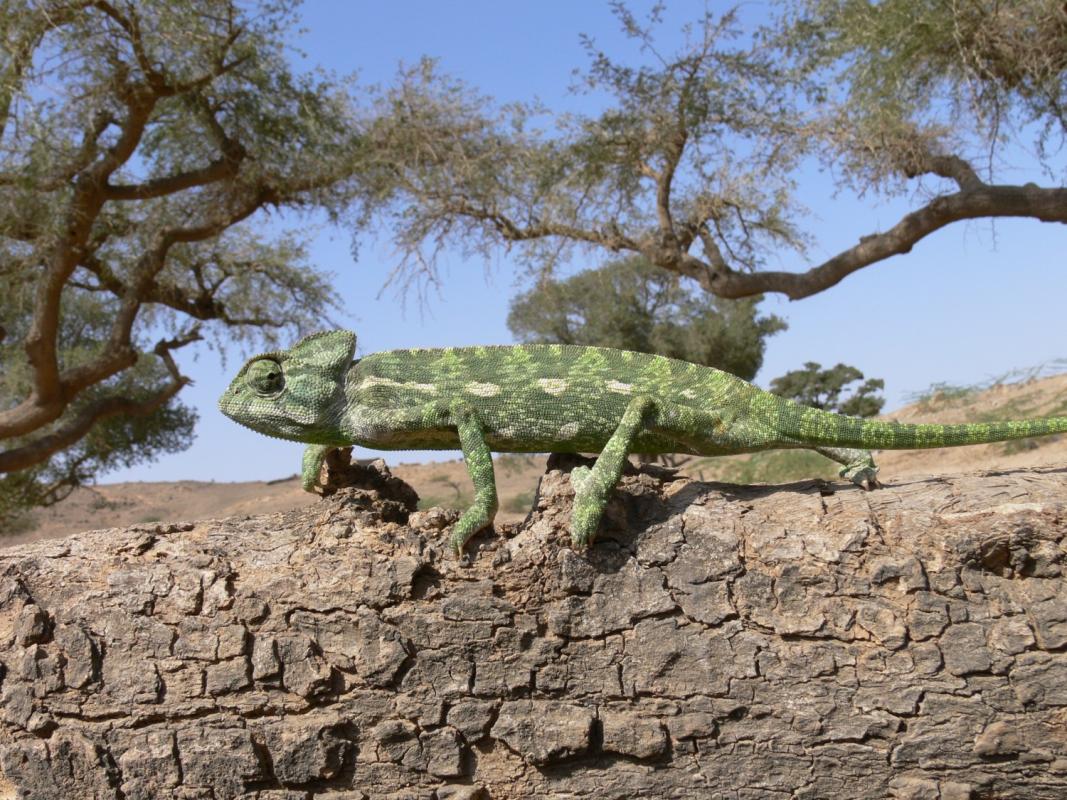Research Topic
Our research concentrates on fossil and extant terrestrial vertebrates, particularly lizards and snakes (Müller), and mammalian herbivores (Bibi). We are especially interested in the underlying causes of evolutionary diversification, both at the taxic and morphological levels, for which we employ anatomical, paleontological, molecular, and ecological methods. Much of our fieldwork takes place in Africa and the Mediterranean, be it fossil prospecting and excavations or studies on extant species ecology and distribution. 3D visualization and computed tomography (CT) are central to our morphological research, and we use these techniques for both qualitative and quantitative studies.
Research Focus
- Evolution of lacertid lizards
The Old-World Lacertidae are one of the most diverse reptile clades in Europe, Africa and Asia, which can be subdivided into a temperate Palearctic group and a largely tropical, African radiation. On the one hand, we study how environmental factors affect the morphological evolution of arid-adapted species, and on the other, we are interested in how temperature influences the behavioral physiology and macroevolution of temperate-adapted clades. Also, we use the Quaternary lacertid fossil record to investigate how environmental change at millennial scales drives microevolutionary dynamics, and we investigate how lacertid lizards living in Berlin adapt to urban environments.
- Evolution of snakes and snake-like body forms
Using amphisbaenians (worm lizards) and scincid lizards as model systems, we investigate how originally quadrupedal reptiles evolved into limbless, body-elongated forms. Also, we study the evolution of true snakes, with special focus on fossil diversification, macroecology, and the evolution of venomousness. In our studies we use a lot of diffusible iodine contrast-enhanced computed tomography (DICE CT) to digitally visualize soft parts like muscles and venom glands in 3D, and we collaborate closely with other labs at the international level to improve DICE CT methodology.
- Pleistocene vertebrate faunas of Sudan
Starting in 2018, our team has been exploring fossil deposits in the upper reaches of the Atbara River valley. Previous work had documented the presence of Middle to Late Pleistocene fauna and stone tools near Khashm el Girba, and our surveys have extended the range of Pleistocene sites in the region over 100 km up the Atbara and Setit Rivers. These deposits document the transition from Acheulean to Middle Stone Age technologies and the evolution of modern African ecosystems during the time of emergence of our species, Homo sapiens. This project comprises an international team led by Faysal Bibi, with Johannes Müller and Robert Bussert (TU Berlin), and in collaboration with colleagues at Al Neelain University, Khartoum University, and African University. It has been supported by a National Geographic Explorer’s Grant and the German Research Foundation (DFG).
- Late Miocene vertebrate faunas of Arabia
Exposed in the Al Gharbia (western) region of the United Arab Emirates are late Miocene rocks of around 7 million years age. Work in the 1980s and 90s led by Andrew Hill (Yale University) and the late Peter Whybrow (Natural History Museum, London) led to the discovery and description of a wide range of animal fossils from this region. Since, 2002, a team led by Faysal Bibi (MfN), Brian Kraatz (Western Univ.), Andrew Hill (Yale), and Mark Beech (Abu Dhabi Department of Tourism and Culture) has more than doubled the previous findings and greatly expanded the number of sites. Our findings include skeletal remains of diverse mammals, fish, birds, and herps which are all in different stages of analysis, and are providing new information on the ancient climate, ecology, and biogeographic relationships of what is today the Arabian desert region. You can read preprints of the upcoming monograph Sands of Time: Ancient Life in the Late Miocene of Abu Dhabi, United Arab Emirates (Springer, 2022), here.
- Evolution and paleoecology of African Bovidae
Antelopes (Bovidae) are the most diverse family of terrestrial large mammals and theyare typically abundant in fossil assemblages from the Neogene of Eurasia and Africa. The adaptation of different bovid clades to particular vegetational and climatic habitats means that they are of great use in the reconstruction of past environmental conditions and ecological relationships. This is particularly the case in Africa, where bovids are often the most abundant mammal found at sites where fossil hominins are discovered. We use the fossil bovid record to reconstruct changes in local habitat and ecological community structure are fossil sites ranging from the late Miocene to late Pleistocene across Africa.
- Conservation Paleobiology in Africa
Together with colleagues from the UK, the U.S., and Kenya, we use the late Cenozoic fossil record in Africa to study the long-term relationships between animals, their traits, and how they respond to changes in their environments, with the goal to use the data to forecast future changes and help inform conservation biology decisions. In this context, we also perform detailed work on fossil collections in East Africa to generate a database of Cenozoic African reptiles. Also, we are involved in several efforts to integrate African scientists and students into this work, with the long-term aim to build an East African museum research & training network.
- Ruminant phylogenetics and diversification
Physical environmental change has been proposed as one of the main drivers of mammalian evolution. Ecological traits modulate the response of organisms to such changes, potentially affecting their capability to shift their geographic distributions, the composition of community assemblages and even their speciation and extinction rates. We use ruminants — e.g. deer, antelopes, giraffes — as a model faunal set for exploring the connections between environmental change, ecological traits, and evolution. This includes a synthesis of both fossil and extant taxa into a single phylogenetic framework, and the calculation of phylogenetic community structure metrics to reconstruct the diversity dynamics (e.g. speciation, extinction patterns) of paleo-communities. The timing of main evolutionary and ecological events can then be compared to the ever-growing record of physical environmental change in order to establish correlations and test existing hypotheses on the relationships of environment and mammalian evolution.
- Quaternary evolution of ectothermic vertebrates
Focusing primarily on Europe and Australia, we study reptile and amphibian communities across the Quaternary with the aim to decipher how community structure and phenotypic expressions are tied to environmental fluctuations, and potentially also to anthropogenic factors. We use 3D imaging and geometric morphometrics to quantitatively assess phenotypic change through time, and we also perform ecological studies on related extant systems. Lately we started working on cave deposits from the Balearic Islands and the late Quaternary site of Pisede in Mecklenburg-Vorpommern.
- 3D Geometric Morphometrics
Quantitative comparisons of cranial shape of extant and fossil species using landmarks digitized on 3D scans provide detailed insights on morphological differences both within and among species, including investigations of size-shape allometry and disparity through time. The Museum für Naturkunde has a state-of-the-art visualization lab with micro-CT and surface (ARTEC) scanners and our group has several ongoing projects on lizards, snakes, bovids, and hippopotamus.
- Museum DNA and Integrative Taxonomy
Many species that are endangered or extinct today are preserved in zoological collections – many such specimens retain genomic information (DNA) that can be extracted and sequenced, illuminating the evolutionary history of these species and populations going back into the Pleistocene. Several ongoing projects use DNA from museum specimens in order to analyze ranges of genomic diversity and phylogeographic structure in extinct or extirpated populations, and the correspondence between molecular and morphological distances (integrative taxonomy)

